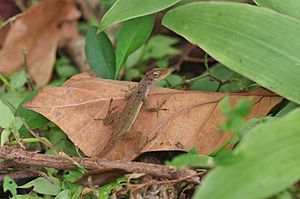Isla San Andres anole facts for kids
Quick facts for kids Isla San Andres anole |
|
|---|---|
 |
|
| Conservation status | |
| Scientific classification | |
| Genus: |
Anolis
|
| Species: |
concolor
|
The Anolis concolor, also known as the Isla San Andres anole, is a type of lizard. It belongs to the family called Dactyloidae. This special lizard can only be found on the island of San Andrés.
Contents
Meet the Isla San Andres Anole
The Isla San Andres anole is a unique lizard species. It was first described by a scientist named Edward Drinker Cope in 1862. This anole is known for living only on one specific island. This makes it an endemic species, meaning it's found nowhere else in the world.
What Does the Isla San Andres Anole Look Like?
Anoles are generally small to medium-sized lizards. Many anole species, including the Isla San Andres anole, are known for their ability to change color. This helps them blend in with their surroundings. They can change color to hide from predators or to show off to other anoles. They often have a long, slender body and a pointed head. Their tails are usually quite long, sometimes even longer than their bodies.
Where Does the Isla San Andres Anole Live?
The Isla San Andres anole lives only on San Andrés Island. This island is located in the Caribbean Sea. It is part of Colombia. The anole lives in the island's natural habitats. These habitats include forests and areas with lots of plants. They like places where they can climb and find shelter.
What Does the Isla San Andres Anole Eat?
Like many other anoles, the Isla San Andres anole is an insectivore. This means its main diet consists of insects. They hunt for small bugs, spiders, and other tiny creatures. They are active hunters, often waiting patiently for their prey. Then, they quickly snatch it up with their tongues. Their diet helps control insect populations in their ecosystem.
Life Cycle and Reproduction
Anoles reproduce by laying eggs. Female anoles lay their eggs in soft soil or hidden spots. This protects the eggs from predators. After a period of time, the eggs hatch. Tiny baby anoles emerge from the eggs. These young anoles are miniature versions of the adults. They must quickly learn to hunt and survive on their own. The life cycle of an anole involves growth and development. They grow from hatchlings to juveniles and then to adult lizards.
Why Is the Isla San Andres Anole Important?
Every species plays a role in its ecosystem. The Isla San Andres anole helps keep the balance of nature on its island. By eating insects, it helps control their numbers. As an endemic species, it is a special part of San Andrés's natural heritage. Protecting its habitat is important for its survival. It also helps protect the unique biodiversity of the island.


